This product qualifies for the following promotions
- SAVE TODAY 25% Discount Applied - Speak to your local showroom or installer for further discounts and special offers & promotions availaible.
Technical Details
| Product Title | OBSOLETE - Arada Ecoburn Plus 5 DEFRA Wood Stove |
|---|---|
| Energy Efficiency | A+ |
| SIA Ecodesign Ready | No |
| Output (Nominal) | 4.9kW |
| Output (Maximum) | 6.5kW |
| Smoke Control (DEFRA) | Yes |
| Boiler Stove | No |
| Colour | Black |
| Flue Outlet Size | 125mm - 5in |
| Fuel | Wood |
| Height | 550mm |
| Width | 431mm |
| Depth | 386mm |
| Nominal Output (Range) | 3kW - 5kW |
| Width (Range) | 400mm - 500mm |
| Nett Efficiency (%) | 78.7 |
| Max log length | 300mm |
| Distance to Combustibles (Side) | 400mm |
| Distance to Combustibles (Rear) | 475mm |
| Style | Traditional |
| Centre of Flue to Rear | 102mm |
| Distance to Combustibles (Top) | 381 |
| 12mm Hearth Compatible | Yes |
Reviews
Defra Approved Stoves > 5kW and Under Defra Stoves

5kW and under Defra Stoves
If you’ve been shopping around for stoves recently, you will probably have heard the term ‘Defra approved’ or smoke exempt’ more than once. Defra approved and smoke exempt (SE) are essentially the same terms used within the stove industry. These terms apply to any stove- wood burning or multifuel- that has been tested by the Department of Environment, Farming and Rural Affairs (Defra) for emissions and deemed suitable for burning in a smoke control area (cities or large towns).
Here at Firebox Stoves, we sell a wide range of 5kW and under Defra approved stoves- both woodburning and multifuel, traditional and contemporary and in a range of sizes. Some stove come Defra approved as standard, whilst others come with an additional kit to be fitted during the installation. From the standard 5kW Defra approved stoves perfect for your average city-sized front room, to smaller 3kW Defra approves stoves, perfect for rooms with less space or high levels of insulation, even boats/ vans!




